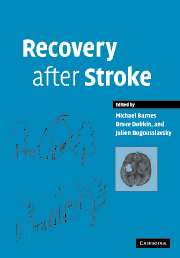Book contents
- Frontmatter
- Contents
- List of authors
- Preface
- 1 Stroke: background, epidemiology, etiology and avoiding recurrence
- 2 Principles of recovery after stroke
- 3 Regenerative ability in the central nervous system
- 4 Cerebral reorganization after sensorimotor stroke
- 5 Some personal lessons from imaging brain in recovery from stroke
- 6 Measurement in stroke: activity and quality of life
- 7 The impact of rehabilitation on stroke outcomes: what is the evidence?
- 8 Is early neurorehabilitation useful?
- 9 Community rehabilitation after stroke: is there no place like home?
- 10 Physical therapy
- 11 Abnormal movements after stroke
- 12 Spasticity and pain after stroke
- 13 Balance disorders and vertigo after stroke: assessment and rehabilitation
- 14 Management of dysphagia after stroke
- 15 Continence and stroke
- 16 Sex and relationships following stroke
- 17 Rehabilitation of visual disorders after stroke
- 18 Aphasia and dysarthria after stroke
- 19 Cognitive recovery after stroke
- 20 Stroke-related dementia
- 21 Depression and fatigue after stroke
- 22 Sleep disorders after stroke
- 23 Technology for recovery after stroke
- 24 Vocational rehabilitation
- 25 A patient's perspective
- Index
1 - Stroke: background, epidemiology, etiology and avoiding recurrence
Published online by Cambridge University Press: 05 August 2016
- Frontmatter
- Contents
- List of authors
- Preface
- 1 Stroke: background, epidemiology, etiology and avoiding recurrence
- 2 Principles of recovery after stroke
- 3 Regenerative ability in the central nervous system
- 4 Cerebral reorganization after sensorimotor stroke
- 5 Some personal lessons from imaging brain in recovery from stroke
- 6 Measurement in stroke: activity and quality of life
- 7 The impact of rehabilitation on stroke outcomes: what is the evidence?
- 8 Is early neurorehabilitation useful?
- 9 Community rehabilitation after stroke: is there no place like home?
- 10 Physical therapy
- 11 Abnormal movements after stroke
- 12 Spasticity and pain after stroke
- 13 Balance disorders and vertigo after stroke: assessment and rehabilitation
- 14 Management of dysphagia after stroke
- 15 Continence and stroke
- 16 Sex and relationships following stroke
- 17 Rehabilitation of visual disorders after stroke
- 18 Aphasia and dysarthria after stroke
- 19 Cognitive recovery after stroke
- 20 Stroke-related dementia
- 21 Depression and fatigue after stroke
- 22 Sleep disorders after stroke
- 23 Technology for recovery after stroke
- 24 Vocational rehabilitation
- 25 A patient's perspective
- Index
Summary
Epidemiology
The impact of stroke
In both the developing and developed countries, the burden of stroke is enormous. Stroke was responsible for 1 in every 15 deaths in the USA in 2001 and, on average, every three minutes someone dies from a stroke (American Heart Association, 2004). Stroke is the second leading cause of death worldwide and the third in developed countries (Murray and Lopez, 1997; Sarti et al., 2000). In 2002, there were more than 5.47 million deaths from cerebrovascular disease worldwide (World Health Organization [WHO], 2003a).
However, stroke is more disabling than lethal, with at least 30% of the survivors making a incomplete recovery and a further 20% requiring assistance for activities of daily living (Bonita et al., 1997). Cerebrovascular diseases are the first cause of serious long-term disability in the USA (American Heart Association, 2004) and the second worldwide in individuals more than 60 years of age (WHO, 2003a). In addition, the psychosocial burden of caregiving should be mentioned. The long-term caregivers of people with stroke more frequently complain of restraints in social life, uncertainty about care needs, constant worries, and feelings of heavy responsibility. A lower quality of life, as well as an increased prevalence of depression, was also found among stroke caregivers (Morimoto et al., 2003).
Finally, because stroke is a leading cause of lost years and disability, it has a very high economic cost. Although the cost may vary according to the type (Bergman et al., 1995; Taylor et al., 1996; Payne et al., 2002) (e.g. hemorrhagic vs. ischemic) and severity of stroke (Caro et al., 2000), the mean lifetime cost for ischemic stroke (IS) including inpatient care, rehabilitation and follow-up is expected to be at US$ 140, 048, and the estimated direct and indirect cost of stroke in the USA for 2004 is US$ 53.6 billion (Taylor et al., 1996; American Heart Association, 2004).
Secular trends in stroke mortality
The mortality from stroke has been clearly changing over time. In the USA, it is estimated that between 1915 and 1968 strokemortality has decreased approximately 1.5% per year, probably as a result of improvements in general public health and nutritional status of the citizens (Wolf and D'Agostino, 1998).
- Type
- Chapter
- Information
- Recovery after Stroke , pp. 1 - 46Publisher: Cambridge University PressPrint publication year: 2005

